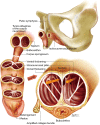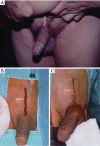Does tunica anatomy matter in penile implant?
- PMID: 26816839
- PMCID: PMC4708595
- DOI: 10.3978/j.issn.2223-4683.2014.03.04
Does tunica anatomy matter in penile implant?
Abstract
Background: Overall prosthesis survival is important in penile implant, which remains the final viable solution to many patients with refractory erectile dysfunction (ED). This paper is to retrospectively study the role of the anatomy of tunica albuginea (TA).
Methods: From March 1987 to March 1991 while the TA was regarded as a circumferential single layer, 21 organically ED men, aged from 27 to 77, received penile prosthesis implantation and were allocated to conventional group. From August 1992 to March 2013 while the tip of Hegar's dilator was categorically directed medial-dorsally during corporal dilatation derived from newfound TA as a bi-layered structure with a 360° complete inner circular layer and a 300° incomplete outer longitudinal coat, 196 ED males, aged from 35 to 83, underwent penile implant and were categorized to advanced group. The model of prosthesis was recorded. Prosthesis loss rate and survival time were analyzed and the follow up period ranged from 22.4-26.4 (average 24.3) years and 0.4-20.6 (average 15.8) years to the conventional and advanced group respectively.
Results: To the conventional and advanced group, the number of inflatable and rigid type prosthesis used were 2, 19 and 15, 181 respectively, whereas the prosthesis loss was encountered in 50.0% (1/2), 15.8% (3/19) and 0.0% (0/15), 0.6% (1/181) respectively. And the prosthesis survival time were 5.1-6.3 (5.7) years, 1.3-26.4 (15.2) years and 6.1-16.2 (11.2) years, 0.4-20.6 (15.3) years to the conventional and advanced group respectively. Statistical significance was noted on prosthesis loss in groups (P=0.01) while the Mentor Acuform stood out in prosthesis survival.
Conclusions: Anatomy-based managing maneuver appears to deliver better surgery success in penile implant. Tunica anatomy is significant in performing implant surgery.
Keywords: Tunica albuginea in human penis (TA in human penis); penile implant; prosthesis extrusion; prosthesis loss.
Conflict of interest statement
Figures





Similar articles
-
Penile prosthesis implant: scientific advances and technological innovations over the last four decades.Transl Androl Urol. 2017 Feb;6(1):37-45. doi: 10.21037/tau.2016.12.06. Transl Androl Urol. 2017. PMID: 28217449 Free PMC article. Review.
-
Comparison of Long-Term Results and Couples' Satisfaction with Penile Implant Types and Brands: Lessons Learned From 883 Patients With Erectile Dysfunction Who Underwent Penile Prosthesis Implantation.J Sex Med. 2019 Jul;16(7):1092-1099. doi: 10.1016/j.jsxm.2019.04.013. Epub 2019 May 31. J Sex Med. 2019. PMID: 31155387
-
[Three-piece inflatable penile prosthesis implantation for the treatment of penile erectile dysfunction].Zhonghua Nan Ke Xue. 2003 Apr;9(2):109-10, 114. Zhonghua Nan Ke Xue. 2003. PMID: 12749129 Chinese.
-
Simultaneous Suprapubic Lipectomy and Penile Prosthesis Implantation.J Sex Med. 2018 Dec;15(12):1818-1823. doi: 10.1016/j.jsxm.2018.10.012. J Sex Med. 2018. PMID: 30527055
-
Penile vascular surgery for treating erectile dysfunction: Current role and future direction.Arab J Urol. 2013 Sep;11(3):254-66. doi: 10.1016/j.aju.2013.05.001. Epub 2013 Jun 10. Arab J Urol. 2013. PMID: 26558090 Free PMC article. Review.
Cited by
-
Penile prosthesis implantation: a systematic review of intraoperative and postoperative complications.Int J Impot Res. 2025 Jun 13. doi: 10.1038/s41443-025-01108-4. Online ahead of print. Int J Impot Res. 2025. PMID: 40514408
-
Management of tunica albuginea disruption secondary to malleable penile implant fracture: insights into etiology and surgical approach.Basic Clin Androl. 2025 Aug 1;35(1):29. doi: 10.1186/s12610-025-00276-z. Basic Clin Androl. 2025. PMID: 40745583 Free PMC article.
-
Penile Wobble Effect: Proximal Corporal Deformities as a Cause of Penile Prosthesis Failure.Sex Med. 2018 Sep;6(3):267-271. doi: 10.1016/j.esxm.2018.04.004. Epub 2018 May 2. Sex Med. 2018. PMID: 29730134 Free PMC article.
-
Penile prosthesis implant: scientific advances and technological innovations over the last four decades.Transl Androl Urol. 2017 Feb;6(1):37-45. doi: 10.21037/tau.2016.12.06. Transl Androl Urol. 2017. PMID: 28217449 Free PMC article. Review.
-
Septum of the penis - dissection, anatomical description and functional relevance.Basic Clin Androl. 2024 Nov 12;34(1):19. doi: 10.1186/s12610-024-00235-0. Basic Clin Androl. 2024. PMID: 39528924 Free PMC article.
References
-
- Hsu GL, Hsieh CH, Wen HS, et al. Formulas for determining the dimensions of venous graft required for penile curvature correction. Int J Androl 2006;29:515-20. - PubMed
-
- Kaminetsky J. Epidemiology and pathophysiology of male sexual dysfunction. Int J Impot Res 2008;20:S3-10. - PubMed
-
- Hsu GL, Lin CW, Hsieh CH, et al. Distal ligament in human glans: a comparative study of penile architecture. J Androl 2005;26:624-8. - PubMed
LinkOut - more resources
Full Text Sources
